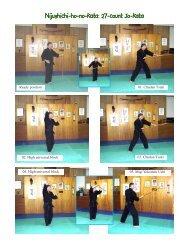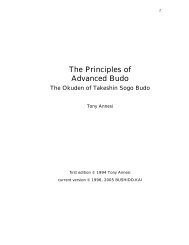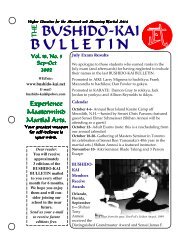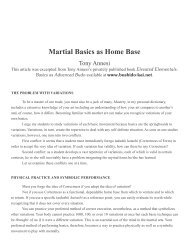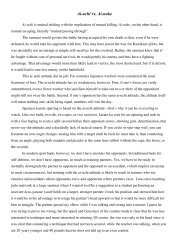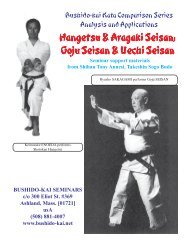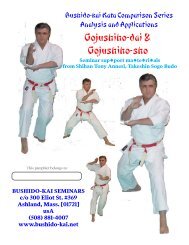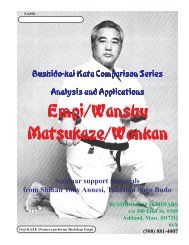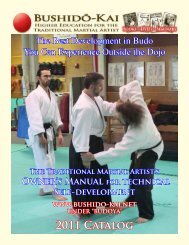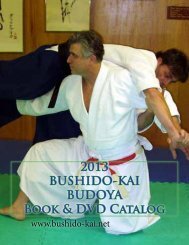Kanku-sho.Bassai-sho.. - Bushido-Kai
Kanku-sho.Bassai-sho.. - Bushido-Kai
Kanku-sho.Bassai-sho.. - Bushido-Kai
Create successful ePaper yourself
Turn your PDF publications into a flip-book with our unique Google optimized e-Paper software.
BASSAI-SHO & KANKU-SHO<br />
Additional Information compiled by Shihan Tony Annesi<br />
History & Name<br />
• -<strong>sho</strong> signifies the lesser of two (-dai signifies the greater of two)<br />
• <strong>Bassai</strong> means Breaking Through a Fortress; <strong>Kanku</strong> means Viewing the Sky<br />
• <strong>Bassai</strong> was originally the Okinawan Patsai; <strong>Kanku</strong> was originally the Okinawan<br />
Kushanku (or Ko<strong>sho</strong>kun)<br />
• The author of both kata is most probably Yasutsune Itosu; therefore, both forms<br />
are considered Shorin in origin The specific form of both <strong>Bassai</strong>-<strong>sho</strong> and <strong>Kanku</strong>-<strong>sho</strong><br />
may have been based on an separate versions of their –dai counterparts rather than<br />
being smaller versions of the prime forms.<br />
General BASSAI-SHO<br />
• There are at least 11 versions of the <strong>Bassai</strong>: Oyadomari, Tomari, Koryu &<br />
Matsumura among them. <strong>Bassai</strong>-Sho may be one of the other <strong>Bassai</strong> kata adopted<br />
by Shotokan and given the name <strong>Bassai</strong>-Sho.<br />
• These <strong>Bassai</strong> Kata may be descended from Chinese forms known as Ba Ji Ch’uan.<br />
There are 2 forms: Ba Ji Da (<strong>Bassai</strong>-dai?) and Ba Ji Xiao (<strong>Bassai</strong>-<strong>sho</strong>?). Ba Ji Xiao is<br />
written exactly the same way as <strong>Bassai</strong>-Sho. This challenges the popular belief that<br />
all -<strong>sho</strong> kata were created by Itosu.<br />
• <strong>Bassai</strong>-Sho has a unique emphasis on stick defenses and counters. This emphasis<br />
upon reacting to attacks from a stick is supposedly typical of an Itosu created kata,<br />
since all of the kata that he heavily influenced contain stick-countering techniques<br />
within them. Supposedly Itosu’s father used to tie him to a stake and poke at him<br />
with a stick to teach him fighting spirit. According to the legend, Itosu was very<br />
interested in techniques that would take a stick away from his father. The legend<br />
would neatly explain a lot about the origin of stick defense in kata, however, the<br />
whole legend is probably just a story with little basis in truth.<br />
• The last two sword hand blocks at the end of <strong>Bassai</strong>-Dai are apparently new creations.<br />
The ending of <strong>Bassai</strong>-Sho is the original ending for our <strong>Bassai</strong>-Dai kata. This<br />
is evidenced by the Shito-Ryu version of <strong>Bassai</strong>-Dai that still ends with the motions<br />
from the concluding techniques of <strong>Bassai</strong>-Sho.<br />
• <strong>Bassai</strong>-<strong>sho</strong> can be interpreted as a kata done with a bo or, conversely, as a kata for<br />
disarming an opponent with a bo.<br />
General KANKU-SHO<br />
• Yara Kushanku, Kushanku, Kushanku Sho, and Shiho Kushanku are the four<br />
<strong>Kanku</strong> kata.<br />
• Possibly one of Itosu’s creations, <strong>Kanku</strong>-Sho contains many of his typical stick<br />
controlling actions and double punches (especially from a horse stance). This technique<br />
is interpreted by Dr. Schmeisser as an “Istanbul Twist” - a technique where



